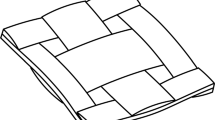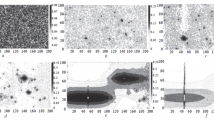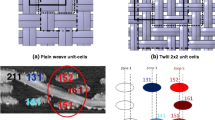Abstract
A meso/macro discrete model of fabric has been developed, accounting for yarn-yarn interactions occurring at the crossing points. The fabric yarns, described initially by a Fourier series development, are discretized into elastic straight bars represented by stretching springs and connected at frictionless hinges by rotational springs. The motion of each node is described by a lateral displacement and a rotation. The compressibility of both yarns is expressed as a kinematic relationship, considering frictionless motions of the yarns. The expression of the reaction force exerted by the transverse yarns at the contact points is then assessed, from which the work of the reaction forces is established. The equilibrium shape of the yarn is obtained as the minimum of its total potential energy, accounting for the work of the reaction forces due to the transverse yarns. Simulations of a traction curve of a single yarn are performed, that evidence the effect of the yarn interactions and the main deformation mechanisms.
Similar content being viewed by others
References
L. Gan, N. G. Ly and G. P. Steeven, Text. Res. J. 65 (1995) 11.
J. W. Eischen, S. Deng and T. Glapp, IEEE Computer graphics and Applications, 1996.
Y. F. Zhao, T. N. Wong, S. T. Tan and W. J. Chen, Computer & Structures, 63 (1997) 1.
P. Boisse, M. Borr, K. Buet and A. Cherouat, Composites Part B 28B (1997).
P. Boisse, A. Gasser and G. Hivet, Composites Part A 32 (2001).
T. Ishikawa and T. Chou, J. Comp. Mater. 17 (1983).
E. H. Glaessgen, C. M. Pastore, O. H. Griffin and A. Birger, Comp. Part B 27 (1996).
P. Boisse, J. L. Daniel, A. Gasser, G. Hivet and D. Soulat, Mec. Ind. 1 (2001).
A. Gasser, P. Boisse and S. Hanklar, Comp. Mater. Sci. 17 (2000) 1.
H. Hing and R. L. Grimsdale, IEEE Computer Graphics and Applications 16 (1996) 5.
B. Ben Boubaker, B. Haussy and J. F. Ganghoffer, CRAS, Série Mécanique 330 (2002).
X. Provot, Graphics Interface, 1995.
J. Page and J. Wang, Finite Element in Analysis and Design 38 (2002) 8.
S. Timoshenko, in “Théorie de la Stabilité Elastique” (Paris & Liège: Beranger, 1947) p. 21.
S. Kawabata, M. Niwa and H. Kawai, Journal of the Textile Institaute 64 (1973) 21.
P. Boisse and M. Borr, C. R. Acad. Sci. Paris, Série II b 323 (1996).
P. Boisse, K. Buet, A. Gasser and J. Launay, Composites Science and Technology 61 (2001).
SNECMA Moteurs. Le Haillan, France. Internal Report, 2002.
Author information
Authors and Affiliations
Corresponding author
Rights and permissions
About this article
Cite this article
Boubaker, B.B., Haussy, B. & Ganghoffer, JF. Mesoscopic fabric models using a discrete mass-spring approach: Yarn-yarn interactions analysis. J Mater Sci 40, 5925–5932 (2005). https://doi.org/10.1007/s10853-005-5056-z
Received:
Accepted:
Issue Date:
DOI: https://doi.org/10.1007/s10853-005-5056-z




